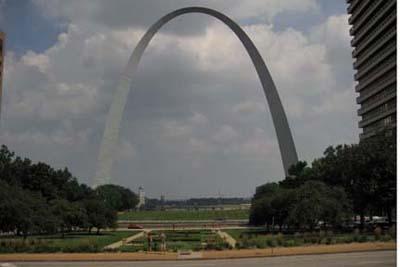The first thing to remember about planning a visit to Jefferson National Expansion Memorial in St. Louis is that the site is much more than the iconic arch. But it's the arch that visitors flock to.
When you're standing under it and looking up to the stainless steel arch, it beats all the pictures you've seen of it. The arch is 630 feet high and 630 feet from end to end, and has the distinction of being America's tallest monument. The modern stainless steel structure represents the Gateway to the West.
The Memorial, located in downtown St. Louis on the Mississippi River across from Illinois, is set in a lovely piece of greenery with walkways and two free-form ponds. The development of the site was a long time in coming. It was first designated a national historic site in 1935, but the arch wasn’t finished until 1965, and the first visitor went up two years later.
A Little History
Before President Thomas Jefferson made the Louisiana Purchase in 1803, the United States ended at the Mississippi River. When the country expanded dramatically, President Jefferson sent Meriwether Lewis and William Clark to find out what was actually contained on this new land. The expedition (1804-1806) took them up the Missouri River, through the Rocky Mountains and eventually to the Pacific. There were other government-sponsored explorations, but the West was now open to the legendary fur traders, mountain men, and soon settlers.
Here are some hints on how to enjoy the whole site: Leave yourself plenty of time - the site is worth almost a full day. Because of its location, Jefferson National Expansion Memorial is used as a city park by St. Louis residents and it can get crowded. There are things to see and do in the Visitor Center and out. Some activities require tickets and you can buy tickets for several combinations of events, saving you money. You can buy tickets on site, but buying tickets in advance on the web is highly recommended.
The City of St. Louis has a marvelous metro system, with a stop for the Arch, one block from the site. The system is well-run and well-signed, much easier to negotiate than driving downtown.
In the Visitor Center
* The highlight of the site is going up to the top of the arch. Visitors sit in a five-person capsule reminiscent of the Jetsons. The four-minute tram ride takes you to the top of the arch where you can get a grand view from both sides of the arch. It is claimed that on a clear day you can see for 30 miles out. On a hot summer Sunday, I waited for an hour on line after my reservation time. Tickets are required.
* Take in the 28-minute movie in the Tucker Theater on how the arch was built. Tickets are required.
* The Odyssey Theater with its wide screen projection and four-story high screen is now showing a 45-minute film on Lewis and Clark's Great Journey West. Tickets are required.
* Plan to spend a while exploring the Museum of Western Expansion. It covers the history from the Louisiana Purchase in 1803 to the closing of the frontier in 1890s. The open-plan space holds a classic teepee and life-sized replicas of horses and a bison. Several modes of transportation are shown, including a red stagecoach trimmed with gold paint, a covered wagon, and a wheel for a steamboat. I would have expected that the museum would be all about Lewis and Clark, but there's surprisingly little about the details of the lives of the two explorers before or after their expedition. Entrance to the museum is free.
* Levee Mercantile is meant to be an old-fashioned store in St. Louis. It offers period hard candy, rag dolls, and other 19th century toys. My eight-year old granddaughter was fascinated by McGuffey’s Eclectic Primer, a reader with short stories that makes Dick and Jane seem risqué. The Primer also illustrates cursive writing including how to link various combinations of letters.
* The visitor center, located underground beneath the arch, has almost airport-like security. Though you don’t have to take off your shoes, you need to go through a metal detector. Rangers look through handbags and daypacks, so remember to leave your pocket knife at home.
Outside the Visitor Center
* You can cruise the Mississippi River on a replica of a 19th-century paddle-wheel boat. They also serve lunch and dinner on the boat. Tickets are required.
* Do not miss the Old Courthouse across the road from the arch. This old County Courthouse was where Dred Scott and his wife sued for their freedom in 1846. The case eventually went up to the Supreme Court in 1857, but it started here. An 18-minute documentary will refresh your memory on the importance of this case.
* In this courthouse, Virginia Minor fought for women’s right to vote. Minor attempted to register to vote in 1872. Her case went up to the Supreme Courtl and she lost her case as well. The Supreme Court decided that each state had the right to decide who could vote within its borders.
* Other rooms in the Courthouse have exhibits showing the settling of the west. The building itself with its beautiful rotunda is worth a visit. If the courthouse was not so close to the arch, it would probably be a historic unit of its own. Entrance is free.
* The Jefferson Memorial site is also one of many points along the Lewis and Clark National Historic Trail. This trail retraces the expedition through 11 states.




Add comment